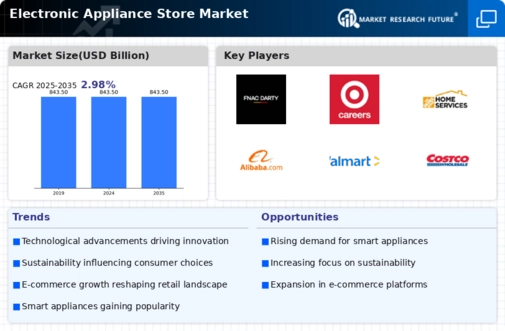E-commerce Growth
The Electronic Appliance Store Market is witnessing a significant shift towards e-commerce, driven by changing consumer shopping behaviors. With the proliferation of online shopping platforms, consumers are increasingly opting to purchase electronic appliances online due to the convenience and variety offered. Recent statistics indicate that online sales of home appliances have seen a substantial increase, with many consumers preferring the ability to compare prices and read reviews before making a purchase. This trend compels traditional brick-and-mortar stores to enhance their online presence and develop robust e-commerce strategies. As a result, electronic appliance stores are investing in digital marketing and logistics to cater to the growing demand for online shopping, which is likely to reshape the competitive landscape of the industry.
Rising Disposable Income
The Electronic Appliance Store Market is benefiting from rising disposable incomes among consumers, particularly in emerging markets. As economic conditions improve, consumers are more willing to invest in high-quality electronic appliances that enhance their lifestyles. This trend is evident in the increasing sales of premium appliances, which often feature advanced technology and superior energy efficiency. Data indicates that households with higher disposable incomes are more likely to purchase smart appliances, further driving growth in the market. Consequently, electronic appliance stores are adapting their product offerings to include a wider range of premium options, catering to the evolving preferences of affluent consumers. This shift is likely to create new opportunities for growth within the industry.
Technological Advancements
The Electronic Appliance Store Market is experiencing a surge in technological advancements, which is reshaping consumer expectations and product offerings. Innovations such as artificial intelligence, Internet of Things (IoT), and smart home integration are becoming increasingly prevalent. These technologies not only enhance the functionality of appliances but also improve energy efficiency, which is a growing concern among consumers. According to recent data, the market for smart appliances is projected to grow significantly, indicating a shift in consumer preferences towards more connected and efficient products. As a result, electronic appliance stores are compelled to adapt their inventory and marketing strategies to align with these technological trends, ensuring they remain competitive in a rapidly evolving landscape.
Increased Focus on Home Improvement
The Electronic Appliance Store Market is experiencing a heightened focus on home improvement, as consumers invest in upgrading their living spaces. This trend is influenced by a growing desire for modern, efficient appliances that complement contemporary home designs. Data suggests that home improvement spending has increased significantly, with many consumers prioritizing renovations that include new electronic appliances. As a result, electronic appliance stores are capitalizing on this trend by offering promotions and packages that cater to home improvement projects. This strategic focus not only drives sales but also positions electronic appliance stores as essential partners in the home renovation process, potentially leading to increased customer loyalty and repeat business.
Consumer Demand for Energy Efficiency
In the Electronic Appliance Store Market, there is a notable increase in consumer demand for energy-efficient appliances. This trend is driven by rising energy costs and heightened awareness of environmental issues. Consumers are increasingly seeking appliances that not only reduce energy consumption but also lower utility bills. Data suggests that energy-efficient appliances can lead to savings of up to 30% on energy costs, making them an attractive option for budget-conscious consumers. Consequently, electronic appliance stores are focusing on stocking a wider range of energy-efficient products, which not only meets consumer demand but also aligns with regulatory standards aimed at reducing carbon footprints. This shift is likely to influence purchasing decisions and drive sales in the industry.


















Leave a Comment